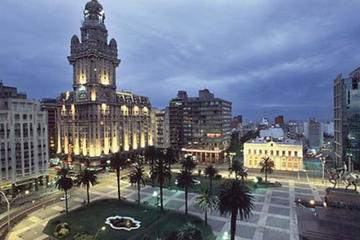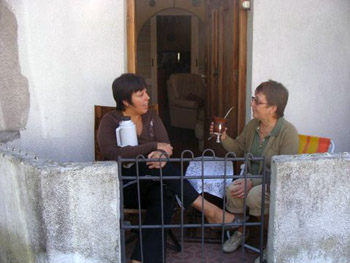
Socializing With Your Mate Uruguayan Style
by Paola Fornari
‘Let’s sit on the zaguán,’ my friend Rosa says. The zaguán is the space between her front door and the street. We squeeze out two plastic folding chairs and a table.
I’ve been invited to matear, Uruguayan style.
Mate is a national social pastime here.
The mate is a calabash: you fill it with a bitter dried leaf called yerba, add boiling water, and sip it through a bombilla – a silver straw. The whole set of mate, bombilla and yerba are also referred to as mate, and the verb, matear, means to sip it.
There are rules: you carry your mate in your hand and flask under your arm, or put everything in a leather case called a matera, but you can’t order it in a bar. It’s something personal, which you pass around your friends. Groups of young people sit in parks, chatting, enjoying the sun and sipping away. In street markets, or even in business meetings, people clutch their calabashes. Kiosks sell hot water to refill flasks. During summer months, when hoards of Uruguayans hit the beaches, first aid centres are set up to deal with burns.
‘Okay, Rosa, I want to get this right.’
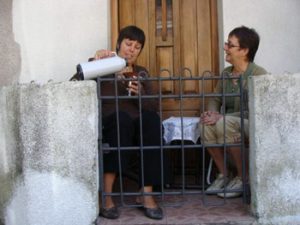 Rosa pours cold water onto one side of the leaves, digs a hollow with her straw, and starts sipping.
Rosa pours cold water onto one side of the leaves, digs a hollow with her straw, and starts sipping.
‘The leaves have to hinchar, to swell. You use cold water at first; otherwise the straw clogs up. I’m inviting, so I sip till the temperature is right. It’s rude if I give it to you luke-warm.’
She sucks, and when a gurgle indicates she has drained her brew, she fills it with boiling water, slurps again, checking the temperature, refills, and hands it to me. I sip. We chat. I learn that is impolite to hand the mate back before the last drop of water is finished. You need that slurpy noise.
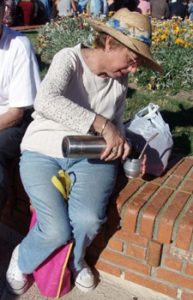 ‘Yuk! You don’t want to sip someone else’s water!’ Rosa says. I wonder about the hygiene of the operation. ‘Most people share with anyone. But I’m selective.’
‘Yuk! You don’t want to sip someone else’s water!’ Rosa says. I wonder about the hygiene of the operation. ‘Most people share with anyone. But I’m selective.’
I’m honoured.
‘I’m the hostess, so I fill. And we chusmear. We gossip about passers- by.’
‘Rosa, if gossiping is part of matear, I’ll go for it.’
‘Ooh, see that woman? She’s asquerosa.’ Nauseating? I wonder why. Rosa explains, ‘She moved into the area and rebuilt the house next door. Loads of money. Moans all the time: says my pipes are wrong, my bathroom is making damp seep into hers…’
A man walks by. I nod and say ‘Buenas tardes.’
‘No, don’t greet, just smile. Don’t say anything unless you know the person.’
‘But I don’t know anyone.’
‘Okay, don’t say anything unless I know them. You have to differentiate between those you know and those you don’t.
An elderly man passes with a dog. ‘Not all there’.
We pass the mate back and forth. Every few fills, Rosa shifts the straw around the wet leaves.
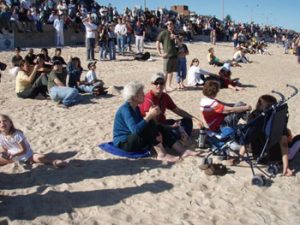 ‘How’s Carmen?’ Rosa asks. She met Carmen at my house recently.
‘How’s Carmen?’ Rosa asks. She met Carmen at my house recently.
‘Ah, poor Carmen, she’s the first of twelve siblings. When she was fifteen, and her youngest brothers, twins, were a few months old, her mother gave one of them away – can you imagine? She handed him over to a stranger, then left. With another man. Carmen didn’t see her again till last week, at a funeral. But Carmen’s kids refuse to call her grandma. Can you blame them?’
Is this me, talking about other people’s affairs, and judging?
Rosa pours the last drops from the flask, and sips the mate del estribo. The dregs.
‘Great, Paola,” she exclaims. “You’ve managed to matear and chusmear, simultaneously. You’re a real Uruguayan now.’
If You Want to Know More:
Mate (drink) in Wikipedia
Welcome Uruguay – about mate
About the author:
Writer, EFL teacher, teacher trainer, and translator, Paola Fornari was born in Tanzania, and has lived in a dozen countries over three continents. She has recently moved from Uruguay to Belgium. She describes herself as an ‘expatriate sin patria’. Wherever she goes she make it her business to learn the language, get to know the local people and customs, and discover the country’s remotest corners. She became interested in writing in mid-2006, did a short Open University creative writing course and a Writers’ bureau course, and began getting articles published in 2007.
Photo Credits:
All photos by Paola Fornari.


